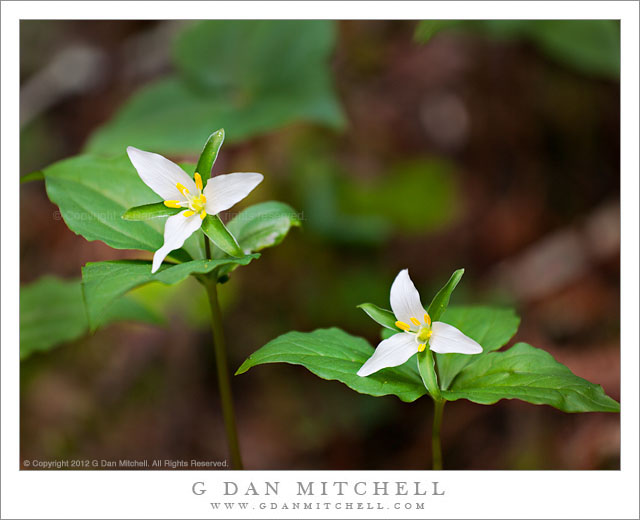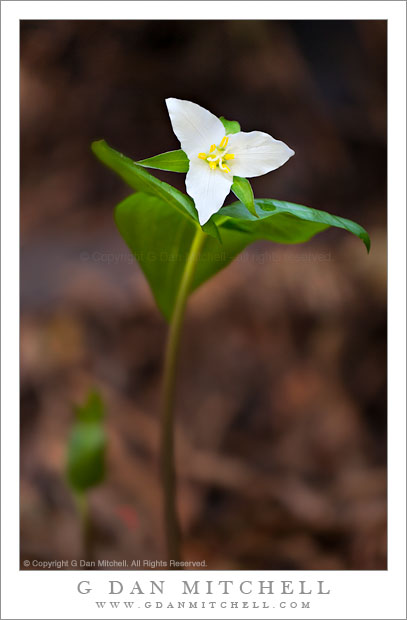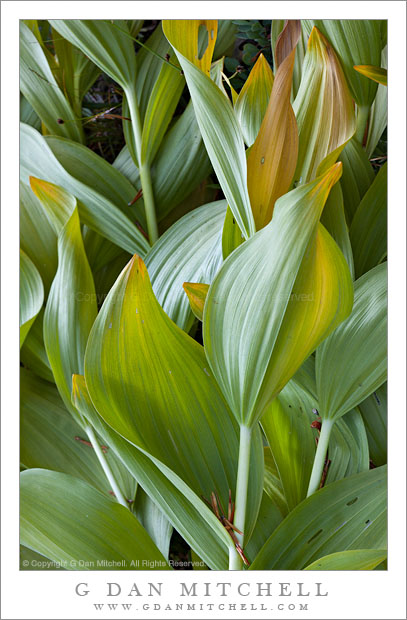
Two Trillium Blossoms. Golden Gate National Recreation Area, California. March 10, 2012. © Copyright 2012 G Dan Mitchell – all rights reserved.
Two trillium blossoms in the redwood forests of the Golden Gate National Recreation Area, California.
It is probably obvious by now that I’m a trillium fanatic. Early March is “trillium season” in the redwood forests around the San Francisco Bay Area, so I have been out photographing these flowers during the past couple of weeks. I was originally concerned that this might be a very poor year for them since we are in the midst of a serious drought in California, but some early March rain seems to have provided enough water to get them to sprout. In fact, this past weekend I saw lots of new plants just starting to emerge, so it seems to me that there may be some life left in the this year’s bloom. (And now we are looking hopefully at an upcoming week of much-needed rain.)
I photographed this pair along a trail that traverses a hillside above a valley filled with coast redwoods. I arrived in this spot just as morning light was beginning to filter down through the tall canopy of this forest and, in spots, hit the ground and the new plants. The trick is is to get some of the brighter color of this sunlight but to avoid the direct sun – the latter is far too harsh for photographing these flowers. So I worked in the shaded areas or, at times, in those spots that were right on the sun/shade boundary. I probably most often photograph single flowers, but when I can find a group I like to see how I can make a composition out of them. It is a bit trickier than it might seem, as there are a bunch of elements that must work together. First, the two flowers need to be fairly close together, and they both need to be at roughly the same point in their development – it isn’t so wonderful to get one beautiful flower and one half-dead, dried hulk. Then they must both be illuminated in roughly the same way – it won’t work so well if one is in brighter light than the other. The background is a tricky thing, too. If it is too bright or too busy (or too well focused) it can easily distract from the flowers themselves, so I usually look for something in shadow and without any very bright objects. While I may be able to find a camera position that accomplishes this, sometimes I need to move a small, bright leaf or twig. And once all of this is worked out, the flowers must be roughly in a plane parallel to the camera’s sensor so that both will be in focus – and this must happen while shooting at the large apertures necessary to throw the background out of focus. And last, but not least, exposure can be slightly tricky – it is very easy to over-expose the bright but delicate form of the flower’s petals, and end up losing detail.
G Dan Mitchell is a California photographer whose subjects include the Pacific coast, redwood forests, central California oak/grasslands, the Sierra Nevada, California deserts, urban landscapes, night photography, and more.
Blog | About | Flickr | Twitter | Facebook | Google+ | 500px.com | LinkedIn | Email
Text, photographs, and other media are © Copyright G Dan Mitchell (or others when indicated) and are not in the public domain and may not be used on websites, blogs, or in other media without advance permission from G Dan Mitchell.



